As a Seneca Pioneer School, [read about the start of the journey here] I decided to roll out a questionnaire to all my classes that I have used Seneca Learning with. Some groups where just introduced to it, others had used it in the previous academic year. I contacted Seneca to see if they would like any particular questions asked. I intended to use the results inform my day to day practice, send some ‘usage’ data to Seneca and to lead some staff CPD next year.
The questionnaire and sheet I used to tally up the results can be download from TES here:
The Groups I test were:
9.4 – A foundation level group that have just started their GCSE Physics course with me.
9T1 – A higher ability group that are mostly higher prior attainers and have chosen triple science as a curriculum option
10.5 – A small group of learners who find science very difficult. They will sit AQA Trilogy.
10.3 – A larger less able/mixed ability group taking AQA Trilogy. I am new to teaching this group this year.
10T1 – A higher ability triple science group. I have taught this group since the beginning of Y9.
11T2 – a mixed ability triple science class. I have taught this group from the start of Y9.
11T1 – a higher ability triple science class. I have taught this group from the start of Y9.
In total 153 students took part in the survey from years 9 to 11.
Question 1:
How easy was it to sign up to Seneca Learning?

98% of students found signing up to Seneca Learning easy or very easy. It was interesting to see that younger found the process more ‘difficult’. It was also noted that some of those students that did find it easy were absent when I went the process.
Question 2:
How easy have you found it to navigate through Seneca Learning?

92% of students found Seneca Learning very easy or easy to Navigate. In total only 1 student (from the Y10 cohort) from Seneca learning ‘very hard’ to log on to.
Question 3:
In General, how have you found Seneca?
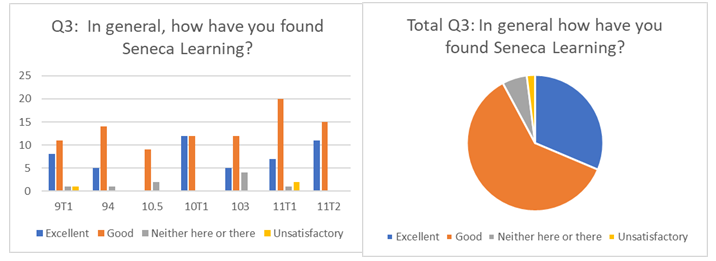
These results show clearly that students enjoy Seneca Learning. With higher triple groups finding the platform better than other groups.
Question 4:
Is Seneca an engaging and productive way to learn?
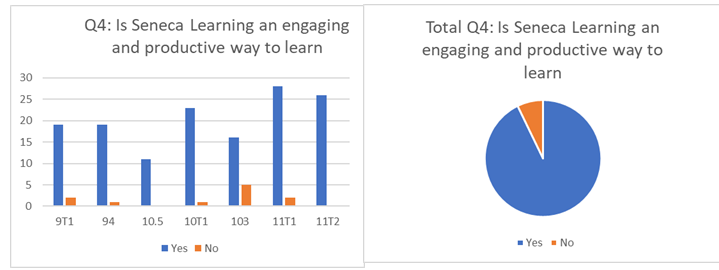
93% of all students who took part in the questionnaire found Seneca engaging and a productive use of their time. The 7% who did not feel it was a useful tool were mostly from the more foundation sets. This could be because of the student not understanding the context and the language used in the units. The group that had the most ‘No’ answers was 10.3 (5 students out of 21) – this group had only just been introduced to the resource so it would be interesting to repeat the questionnaire at the end of year to see if this has changed.
Question 5:
Has Seneca helped you learn?

Again a really positive outcome for Seneca Learning with 85% of students find Seneca helps them learn (56% some, 29% Lots)
Question 6:
Have you noticed you make more progress when you use Seneca?

Only 7% of students said they do not make any more progress than they normally would when the use Seneca Learning (this was only 10 students out of 153). 16% make lots more progress, 56% make some progress and 22% of students make a little more progress.
5 out of the 10 students who mentioned they do not make any progress were from my foundation year class, who had only just been introduced to Seneca. In 3 of the 7 classes questions every single student noted they make at least a little progress.
Question 7:
Does Seneca help you help the course content? And how?
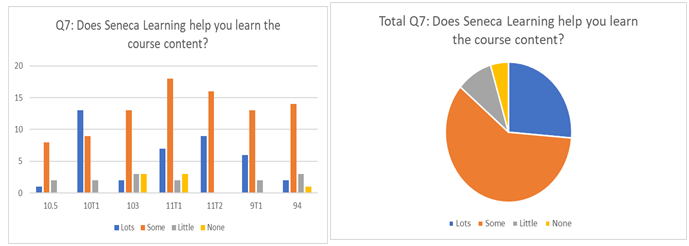
Only 5% of students claimed that Seneca Learning does not help them learn at all. 26% believe Seneca helps them lots, 60% believe Seneca helps them sometimes and 9% claim it helps them a little bit.
Once again 3 of the 7 students who claimed Seneca does not help them at all were from the foundation year 10 group. 3 students from 11T1 also made this claim, possibly because of the reasons given in question 14.
These were the reasons students gave as to why Seneca was useful for them.
“Mostly easy to read”
“Interactive”
“Gives you the answer & corrects mistakes”
“You can go back over the questions”
“Good for revision”
“The repetition of the questions is useful”
“You have to read the questions to answer the question”
“Lots of extra facts and information”
“Key information is explained well and it is fun”
“Helps me retain information”
“Different types of questions”
“Helps me remember as it explains things in a different way”
“I’ve learnt lots just by using Seneca”
“Seneca keeps my focus”
“Helps with my understanding so I wont make the same mistake again”
“I remember the pictures and diagrams”
“Engaging and a fun way to learn”
“Covers all the course content and questions ensure you through it thoroughly”
“Teaches you step by step”
“Helps me remember info to store in my head as it is all in my head”
“Highlights my weaknesses”
Question 8:
Compared to other revision / Learning Resources how does Seneca compare?

Compared to other revision sources it is clear Seneca Learning is preferred by many students. 63% of students asked believe Seneca is better than anything else they have used. 32% believe the resource is parallel to other sources. 5% of students have used better sources of revision for them. This is surely expected as one program or type of revision will not suit everyone.
This questionnaire was completed before Seneca Learning introduced the ‘classes and assignments’ section and teachers were able to set and push out assignments to teachers.
Question 9:
When have you used Seneca Learning?

Students had the option to answer more than once on this question or not at all. As an over view it is clear to see the ‘T’ (triple) groups used Seneca Learning far more in their own time at school and at home compared the less able groups.
In total 25% of the students asked said they have used Seneca Learning in their own time at school and 48% claimed they use Seneca Learning In their own time at home. It is unsure at this time whether or not students who said they use Seneca in their time, may have been asked to use Seneca Learning for home learning.
Question 10:
If you log into Seneca Learning in your own time, how long do you spend using it?

This was an interesting question. Only students that used Seneca in their own time had to answer it. 45% of students used Seneca Learning for under an hour in their own time. 27% used it between 1 to 3 hours (41 students), 3% (5 students) used it for 3-5 hours, 4 students used it for 5 to 10 hours and 1 student 10 hours plus.
On reflection this was not a great question, as I did not make it clear if this over the course of one day, one week or the total usage. Even so, once again it is clear that the higher attaining students from
Question 11:
Which platforms do you use to log into Seneca?

Students could answer multiply choices on these questions – in fact some answered all four. The device used most to access Seneca was using a PC/Laptop. Students did comment saying they may use tablets/Ipads and mobile devices more in there was an app available. Students were more likely to use a device at home but a PC in school.
Question 12:
Which subjects do you revise with the most on Seneca? (is your teacher aware?)
I believe I was the first member of staff at my school to introduce Seneca to the students. Feedback I received from this question shows that most students are using Seneca at various times across the curriculum to revise and learn in most subject areas, most teachers were not aware of this.
Question 13:
What is your favourite feature/aspect of Seneca?
There were many positive comments, that demonstrate the impact that Seneca has on student achievement. The most common comments include how easy and fun Seneca is, along with the use of the audio and visual elements that are embedded within the courses.
Here are some of the comments made by students in each class:
93
“Good mix of easy/hard questions”
“Good that you can see your mistakes”
“The videos are useful”
“Like that you can see your progress”
“The knowledge score and leaderboard”
9T1
“Easy to learn with”
“content is well explained”
“Easy to navigate”
“I like the world memory”
“The toggle questions”
“You can join your class”
“simple to use”
“Visuals are good as are the tests/questions”
10.5
“I like competing against friends”
“Audio and visuals are good”
“lots of subjects and courses”
“makes learning fun”
10.3
“useful facts”
“I like the memory palace”
“Lots of different types of questions”
“Shows how much you have done”
“layout is easy to use”
10T1
“Good variety of questions and courses available”
“I like the images, GIFS and videos”
“Ease of navigation – laid out clearly & simple to use”
“Progress score”
“It is good when questions are repeated”
“Like the multiply choice questions”
“Memory storage”
“Competition between peers”
“I like the fact you can redo courses until you get 100%”
11T2
“Types of questions”
“Gifs and Videos”
“you need to get it right before you move on and can repeat”
“Interactive memories and knowledge score”
“Builds knowledge up”
“Wide range of subjects and questions”
“Interactive and rewarding”
“Clear and engaging”
11T1
“Repeat the questions if you get them wrong”
“Good to see the blue circle fill up”
“Memories and the knowledge score”
“Interactive, quick and easy”
Question 14:
How could Seneca Learning be improved?
The students really thought long and hard about this question. I was very impressed with the fact, many students really wanted to propose sensible suggestions. Some of most common themes from the higher tier students were:
- Increasing the difficulty of the some of the questions
- Longer exam style questions
- More difficult to get questions correct (no autofill) + and at times the answer need is very random
- Past paper type activities and questions
Foundation Tier students found:
- Sometimes the language was too advanced – could some kind of dictionary be included or key word list with definition.
- Extra quizzes
- Learning Games included
9.3
“Some questions are too hard”
“more tips to help remember staff – like jokes and songs”
“The questions that you toggle are too easy because they are coloured”
9T1
“More detail as to what you have got wrong”
“A warning box that pops up in case you press continue by accident”
“make your own nickname”
“more questions on topics”
“more choices for storage/memory palace”
“Even if I get all questions correct, I don’t get 100%”
“Some of the language is a difficult to understand sometimes – so explanation on key language of a link to a dictionary”
“I would like to see virtual rewards”
“Clear timers”
“More information and detail if you fail a question”
10.5
“Write your own name/nickname”
“Create avatars for yourself”
“Download the app in the app store”
“I want to see learning games and activities”
10.3
“Easier to find things”
“Make it more fun and interactive – like include games”
“Add extra video links”
“More fun quizzes”
“Add more vocational courses like Agriculture”
10T1
“Timed questions”
“Include harder exam style questions”
“Exam style exam papers”
“More quizzes”
“Choice of harder/easier questions”
“longer lessons dedicated to harder subjects”
11T2
“Higher / Foundation tier toggle option”
“Extra links for help and support”
“Different types of questions”
“Too easy to cheat!”
“Increase level of difficulty”
“Exam style questions”
“Past paper questions”
11T1
“Higher tier needs less autocorrect – you get the answer right sometimes when it should be wrong”
“More detail”
“Answers to fill in can be very random at times”
“More questions with a higher level of challenge”
“Extra style questions – with less multiply choice – more 4/6 mark questions”
“Individual class leader boards that are visible to the whole class”
Next Steps
The answers to this questionnaire has informed me that Seneca is a positive learning tool to have in the classroom. Hopefully results will see an improvement in student attainment. I personally will be using it more to set further home learning.
I will also be feeding some this to the whole school during an INSET later this term.












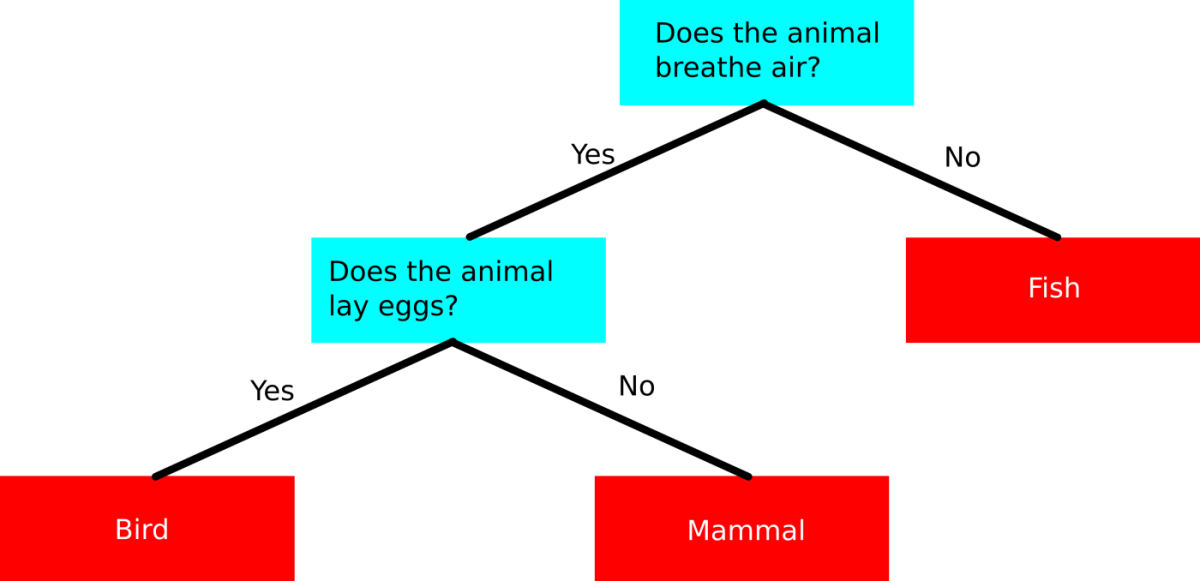







 6 questions for a low stakes assessment. If they do not know the answer – I now get them to write the question out as well. This example of routine self quizzing is a win win starter and is linked to the “Forgetting Curve” which was first described by Hermann Ebbinghaus. Ebbinghaus explains that information is lost over time and in order to “recall” this information we must first “retrieve” it. He also suggested that if you have forgotten something and then retrieve it, it will stay in your memory for longer. I use this idea, and idea of retrieval practice which is explained very well with
6 questions for a low stakes assessment. If they do not know the answer – I now get them to write the question out as well. This example of routine self quizzing is a win win starter and is linked to the “Forgetting Curve” which was first described by Hermann Ebbinghaus. Ebbinghaus explains that information is lost over time and in order to “recall” this information we must first “retrieve” it. He also suggested that if you have forgotten something and then retrieve it, it will stay in your memory for longer. I use this idea, and idea of retrieval practice which is explained very well with 



















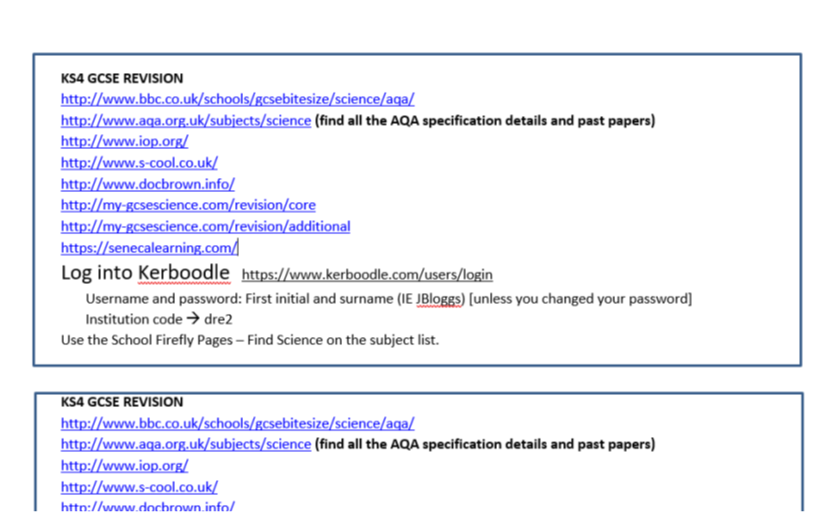



 raphs in as students left as an exit ticket – the photo shows some examples of the responses.
raphs in as students left as an exit ticket – the photo shows some examples of the responses.

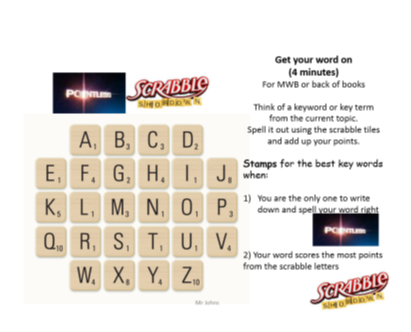







 have attempted to order them):
have attempted to order them):



